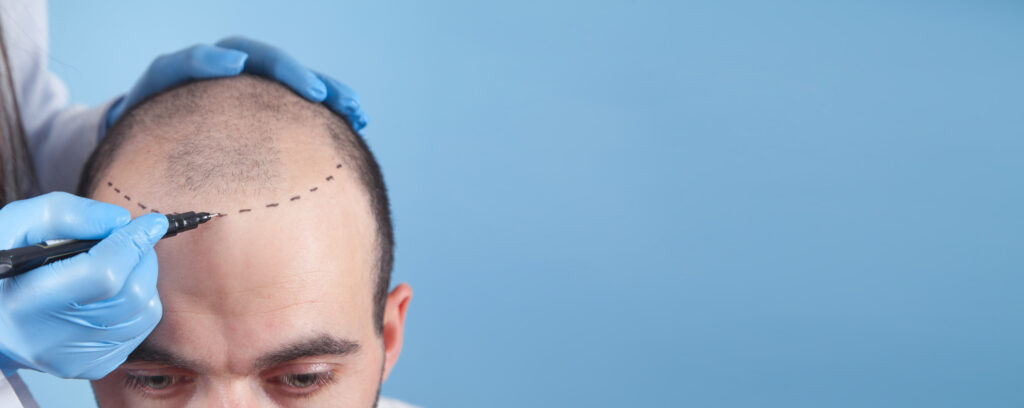Table of Contents
Table of Contents
SMP Training Duration: What to Expect on Your Journey to Certification”
Becoming a successful Scalp Micropigmentation (SMP) artist requires certain skills and knowledge, as well as dedication and hard work. It is not an easy process and may take quite some time to master the craft. Generally speaking, it can take anywhere from two to five years of practice to become highly proficient in SMP techniques.
It’s important to have some formal education in aesthetics or beauty related fields before beginning your SMP journey; the more studied you are in these areas, the easier it will be for you to understand the principles at play with SMP treatments. The basis of all scalp micropigmentation involves a thorough understanding of hair anatomy and pigmentation theory, so having a background in this area is essential. Additionally, knowledge of basic facial anatomy, colour theory/matching, topical anaesthesia/numbing agents, infection prevention/sterilization measures are also recommended prior to beginning any type of scalp micropigmentation treatments.
From there, pursuing hands-on training is key in order to properly apply pigment into the dermal layers of skin; this includes learning about the different types of pigments used for various treatments and how they interact with different skin tones and application styles. Different types of needles should also be tested extensively before use on humans; practitioners must familiarize themselves with various types such as flat needles versus round needles when creating hairlines or covering alopecia spots. Practicing on synthetic skin or latex heads is helpful for honing your technique before treating real clients.
If you’re considering a career in scalp micropigmentation (SMP), one of the most common questions is about the timeline. How long does it take to become an SMP artist? The short answer is that while basic training can be completed in just a few days, becoming a truly proficient SMP artist typically takes 6-12 months of dedicated practice and development.
The Training Phase: Just the Beginning
Many aspiring SMP artists are surprised to learn that the initial training period is relatively brief:
- Fundamental SMP training courses: 3-5 days
- Advanced techniques workshops: 1-3 days per specialization
- Total basic certification time: Approximately 1-2 weeks
“The misconception many people have is that they’ll be expert SMP artists after a week-long course,” explains James Harrison, head trainer at UK Scalp Micropigmentation Academy. “In reality, the formal training is just the beginning of your journey. It provides the foundation, but true proficiency comes with time and practice.”
The Proficiency Timeline: A More Realistic View
Becoming a competent SMP artist involves several developmental stages:
1. Foundational Knowledge (1-2 weeks)
During formal training, you’ll learn:
- Basic SMP techniques and theory
- Machine operation and needle selection
- Pigment mixing and color theory
- Practice on synthetic skin models
2. Initial Practice Phase (2-3 months)
After training, most new SMP artists:
- Practice extensively on synthetic skin
- Work on 5-10 volunteer models at reduced rates
- Focus on basic technique refinement
- Develop consistent dot patterns
3. Skill Development Phase (3-6 months)
During this critical period:
- Techniques become more natural and intuitive
- Speed and efficiency improve
- Confidence with different skin types develops
- Client consultation skills strengthen
4. Professional Competence (6-12 months)
By this stage, most dedicated practitioners:
- Produce consistently professional results
- Handle diverse client needs confidently
- Work at commercially viable speeds
- Command full market rates
“In my experience training over 200 SMP artists, those who achieve excellence most quickly immerse themselves completely in the craft,” notes Emma Thompson, founder of Elite SMP Training. “The practitioners who practice daily, seek regular feedback, and study the work of established artists typically reach professional-level competence within 6-9 months.”
Factors Affecting Your Timeline

Several variables can influence how quickly you progress:
Natural Aptitude
Those with existing artistic abilities, steady hands, and excellent eye-hand coordination often progress faster. Previous experience with tattooing, microblading, or medical aesthetics can also accelerate the learning curve.
Practice Frequency
“The single biggest factor in development speed is consistent practice,” emphasizes David Williams, a London-based SMP artist. “I’ve seen talented individuals who practiced sporadically take years to reach professional standards, while dedicated practitioners with moderate natural ability achieved excellence in just months through daily practice.”
Mentorship Quality
Access to ongoing guidance from experienced practitioners significantly impacts development. Those with regular feedback from established SMP artists typically progress much faster than those learning in isolation.
Business Focus
Practitioners focusing exclusively on SMP typically develop more quickly than those treating it as a secondary service alongside other aesthetic offerings.
The Journey Doesn’t End with Proficiency
Even after achieving baseline competence, most successful SMP artists continue their education:
- Attend advanced masterclasses (1-2 per year)
- Learn specialized techniques for diverse client needs
- Stay current with evolving industry standards
“Becoming an SMP artist isn’t a destination but a continuing journey,” reflects Michael Davis, who has practiced SMP for seven years. “I’m still evolving my techniques and learning new approaches even after thousands of successful procedures.”
The Realistic Bottom Line
While marketing for training academies often suggests you can become an SMP artist in just a few days, the reality is more nuanced. The journey from complete beginner to confident, skillful practitioner typically takes:
- Minimum timeline: 6 months with intensive, daily practice
- Average timeline: 9-12 months of dedicated development
- Extended timeline: 12-18+ months with part-time focus
For those committed to excellence in this rewarding field, understanding this realistic timeline helps set appropriate expectations and ensures you’re fully prepared for the professional journey ahead.
In addition to being knowledgeable about proper SMP technique, practitioners should also understand concepts such as aftercare instructions for clients these include avoiding sun exposure immediately following treatment and using post-treatment products such as moisturizers or sunscreen that will protect their new look while maintaining its longevity. Understanding other aspects such as pricing models or marketing strategies can also help build a successful career in scalp micropigmentation services.
Overall, it takes significant time and effort to become an expert practitioner in SMP; however, with proper training and practice one can build proficiency over a period of 2-5 years depending on their dedication level and willingness to constantly improve their skillset.

